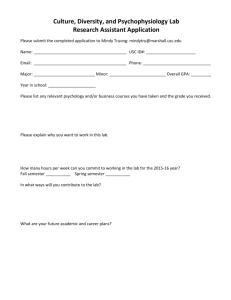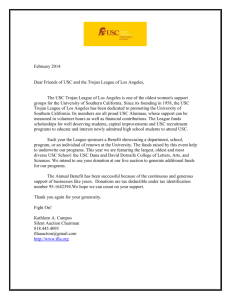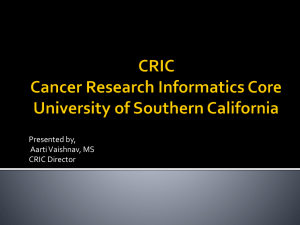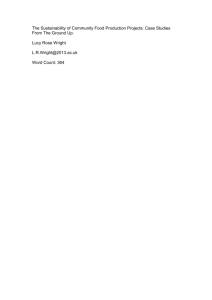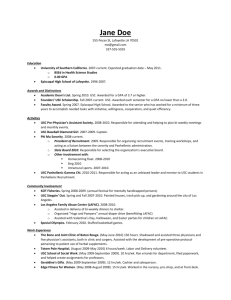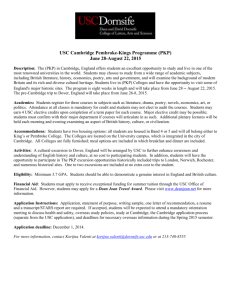MuHL 232: Music History II
advertisement
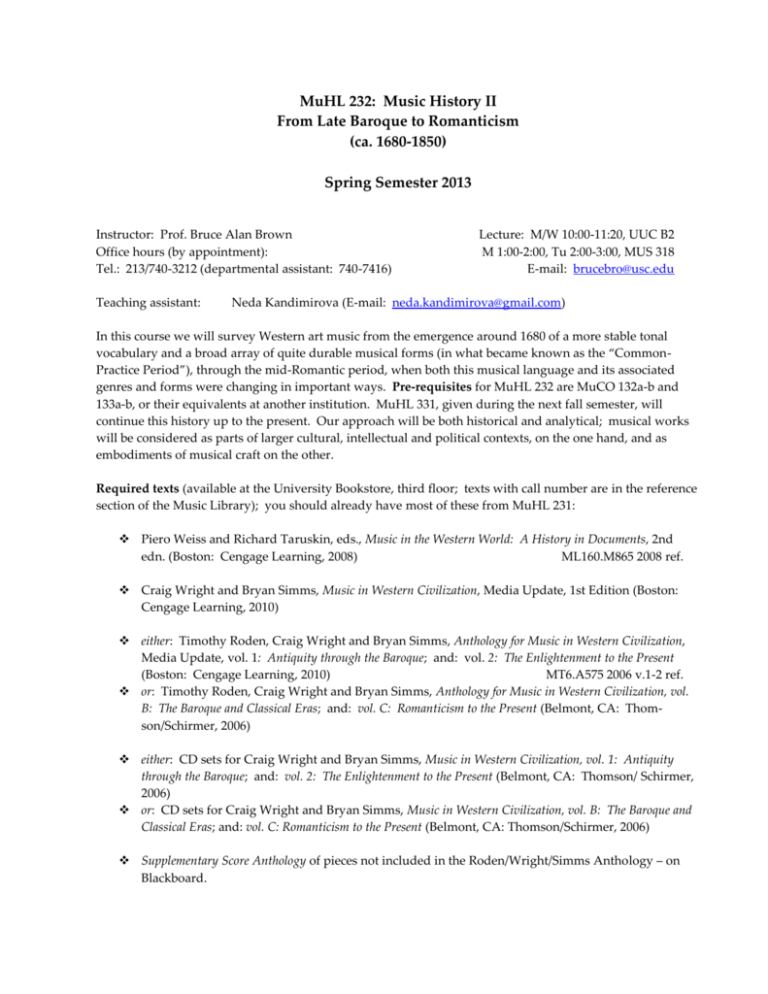
MuHL 232: Music History II From Late Baroque to Romanticism (ca. 1680-1850) Spring Semester 2013 Instructor: Prof. Bruce Alan Brown Office hours (by appointment): Tel.: 213/740-3212 (departmental assistant: 740-7416) Teaching assistant: Lecture: M/W 10:00-11:20, UUC B2 M 1:00-2:00, Tu 2:00-3:00, MUS 318 E-mail: brucebro@usc.edu Neda Kandimirova (E-mail: neda.kandimirova@gmail.com) In this course we will survey Western art music from the emergence around 1680 of a more stable tonal vocabulary and a broad array of quite durable musical forms (in what became known as the “CommonPractice Period”), through the mid-Romantic period, when both this musical language and its associated genres and forms were changing in important ways. Pre-requisites for MuHL 232 are MuCO 132a-b and 133a-b, or their equivalents at another institution. MuHL 331, given during the next fall semester, will continue this history up to the present. Our approach will be both historical and analytical; musical works will be considered as parts of larger cultural, intellectual and political contexts, on the one hand, and as embodiments of musical craft on the other. Required texts (available at the University Bookstore, third floor; texts with call number are in the reference section of the Music Library); you should already have most of these from MuHL 231: Piero Weiss and Richard Taruskin, eds., Music in the Western World: A History in Documents, 2nd edn. (Boston: Cengage Learning, 2008) ML160.M865 2008 ref. Craig Wright and Bryan Simms, Music in Western Civilization, Media Update, 1st Edition (Boston: Cengage Learning, 2010) either: Timothy Roden, Craig Wright and Bryan Simms, Anthology for Music in Western Civilization, Media Update, vol. 1: Antiquity through the Baroque; and: vol. 2: The Enlightenment to the Present (Boston: Cengage Learning, 2010) MT6.A575 2006 v.1-2 ref. or: Timothy Roden, Craig Wright and Bryan Simms, Anthology for Music in Western Civilization, vol. B: The Baroque and Classical Eras; and: vol. C: Romanticism to the Present (Belmont, CA: Thomson/Schirmer, 2006) either: CD sets for Craig Wright and Bryan Simms, Music in Western Civilization, vol. 1: Antiquity through the Baroque; and: vol. 2: The Enlightenment to the Present (Belmont, CA: Thomson/ Schirmer, 2006) or: CD sets for Craig Wright and Bryan Simms, Music in Western Civilization, vol. B: The Baroque and Classical Eras; and: vol. C: Romanticism to the Present (Belmont, CA: Thomson/Schirmer, 2006) Supplementary Score Anthology of pieces not included in the Roden/Wright/Simms Anthology – on Blackboard. 2 Our basic text will be Wright/Simms, which will be useful both for general background and for analysis of specific works. Readings are assigned for each lecture, but you may also find it helpful to browse in other chapters or sections, and in the glossary. NB: The textbook is not a substitute for lectures, on which exams will primarily be based. Weiss and Taruskin's anthology of primary writings on music aims to give a more direct feeling for the history of music by presenting the documents themselves, rather than a filtered interpretation of them. You should try to keep up to date with readings in both this book and the main textbook. The choice of pieces has been dictated in large part by the selection offered in the Roden/Wright/ Simms Anthology. These are pieces that history has “canonized” as first-rate examples of their forms and styles. The main advantages to using an anthology are: 1) ease of reference while listening in class, or away from the library, 2) freedom to mark the scores – which you may not do with library scores! – and 3) low cost, compared to what you'd pay for all these scores separately. Please bring your anthology to every class in which we will cover works included there (check the schedule of lectures below). Scores of works not included in the published anthology will be in a Supplementary Score Anthology, available on Blackboard. Please look ahead in the schedule of lectures in the syllabus and either print out the score(s) you’ll need for a given lecture, or bring your computer to that lecture so you can read the score(s) online. Scores and other library materials meant for use in connection with writing projects will be on reserve in the Music Library, or on Ares electronic reserves, or on Blackboard. Most reserve and reference scores may be used in the Music Library only. This class will use Blackboard for announcements, posting of assignments and handouts, online discussions (some of them mandatory and/or for grade credit), and submission of papers. SUGGESTED FURTHER READINGS Source readings (in addition to Weiss/Taruskin): Oliver Strunk, ed., Source Readings in Music History, rev. edn. by Leo Treitler (New York: Norton, 1998) ML60 S89 1998 ref. A more comprehensive survey of music history: Richard Taruskin, The Oxford History of Western Music. 6 vols. Oxford and New York: Oxford University Press, 2005. Vol. 2: The seventeenth and eighteenth centuries; vol. 3: The Nineteenth Century ML160.T18 2005 v. 4-5 ref. Grove dictionaries (in the Music Library's reference section): Stanley Sadie and John Tyrrell, eds., The New Grove Dictionary of Music and Musicians, revised edn. (London: Macmillan, 2001; online version at www.grovemusic.com) ML100.N48 200 ref. Stanley Sadie, ed., The New Grove Dictionary of Opera (London: Macmillan, 1992; online version at www.grovemusic.com) ML102.O6N5 1992 ref. Online sources of scores: Classical Scores Library: go to http://www.usc.edu/libraries/, then click on “Resources by Subject” (under “Popular Links”) > “Music” > “Find Scores” tab, and then scroll down to “Scores Databases.” International Music Score Library Project (IMSLP/Petrucci): http://imslp.org/wiki/Main_Page 3 Listening: Assigned class listenings are largely available in the CD set that accompanies the Wright/Simms textbook. A few supplemental assigned listenings are available on a class website (http://www.usc.edu/schools/music/music_history-brown/muhl280a/listening.html; MuHL 280a was the number for a previous version of this course), accessible with a user i.d. and password (to be given out in class). As a necessary precaution (in terms of copyright), access to the class website is restricted to USC IP addresses; if using the site from an outside system (e.g., cable or DSL), or even USC’s WiFi, you will have to install USC’s VPN (virtual private network) software; see http://www.usc.edu/its/vpn/ For pieces on the website, you can listen from any computer with an Internet connection and the (free) RealPlayer program on it. (Note: The Music Library's computers are not equipped with RealPlayer.) A separate sheet of instructions for the website will be distributed in class. (Note: On some computers, you may need to right-click and download the file (e.g., to your desktop) in order for it to play.) You can listen to many of the assigned pieces on one of the Music Library’s streaming audio and video services, such as Classical Music Library, Naxos Music Library, or Opera in Video. Follow the same instructions as for the Classical Scores Library (above), but click the “Find Sound Recordings” or “Find Videos” tab, and then either “Music Online” (under “Streaming Audio Services” or “Video Databases”). For Classical Music Library, use the “Go to” window to narrow your search. Classical Music Library has playlists that duplicate the contents of the Simms/Wright CD anthology (though with different performances); click the “Playlists” tab and search for “Companion to Wright”; this will bring up the playlists. Wherever and however you listen, you should plan a regular schedule of at least two listening sessions per week, in order to keep up with lectures. Do not leave all your listening to just before exams! You may also check out the Music Library's regular CDs (see Homer catalogue), for use in the library, or purchase commercial recordings of some of the pieces from the listening list, on your own. Performances of many of our pieces can also be found on http://www.youtube.com/, iTunes, and/or Spotify. Attendance: Attendance is mandatory, and will be checked most days. You are responsible for all material, whether you were there when it was presented or not. If for some legitimate reason you must miss class, arrive late, or leave early, please inform me in advance (in person, by phone or by e-mail. Unexcused absences or tardiness will cause your grade in the class to be lowered. Legitimate excuses include illness, personal emergencies, or occasional conflicts with master classes or rehearsals of large ensembles, but NOT lessons or outside gigs. General expectations: Regardless of educational, linguistic, or national background, all students in this course are expected to have a good command of spoken and written English. You should come to class prepared to take full and accurate notes on lectures, and to participate in discussions. If you are having trouble following the lectures, try 1) sitting closer to the front of the room, 2) recording lectures, and 3) getting help outside of class. But if you are still having trouble, or spending too much time on coursework, after trying these remedies, you should consider dropping the class and waiting to take it until you are better prepared. Please feel free to talk to me or the teaching assistant about any problems you are having. Written work, apart from tests, will normally be submitted electronically. On a title page include your name (student identification number is not necessary), the course number, the date the work was submitted, and the title of the assignment ; your main text should be double spaced. All work must be entirely your own, unless you are specifically instructed to collaborate. See the guidelines on academic integrity (the URL is given below) if you are uncertain as to what constitutes plagiarism, or proper and improper use of sources. Since this class covers a large amount of material, it is to your advantage to make use of my office hours – not only if you are having problems with the material, but also simply in order to find out on a topic 4 more than can be covered in class. The pieces and information covered in class are only a starting point; don't limit yourself to just that! The teaching assistant will also be holding office hours (though not always in an actual office). Times and places will be announced in class. You may use computers for note-taking during lecture, and for accessing Internet resources as directed by me, but please refrain from e-mail, telephoning (including texting), Facebook, and other electronic activities that are unrelated to class. Non-class-related electronic activity during lecture may result in confiscation of phones, expulsion for the rest of the lecture, and/or a grade penalty. All students enrolled in MuHL 232 MUST have completed, with a passing grade, MuCO 132a-b and MuCO 133a-b, or their equivalents at another institution – as measured by the MuCO Equivalency Exam. Any student requesting academic accommodations based on a disability is required to register with Disability Services and Programs (DSP) each semester. A letter of verification for approved accommodations can be obtained from DSP. Please be sure the letter is delivered to me as early in the semester as possible. DSP is located in STU 301 and is open from 8:30 a.m. to 5:00 p.m., Monday through Friday; phone: 213/7400776. Evaluation: 2 midterm exams (20% ea.) and a final exam (25%); these involve definitions and term/person identifications, listening and objective questions (including geographical ones), and short essays. Exams are based on lectures, and assigned readings and listenings, and are not cumulative. 2-3 short listening quizzes, as announced (5% total). No make-ups are possible; I will throw out your lowest score of the two or three quizzes. 1 or more written assignments (20% total), either analytical or historical in nature, on pieces, readings, or topics to be assigned; due (on Blackboard) as announced in class. Class participation (5%): active, productive participation in class and online (Blackboard) discussions, and demonstration of acquaintance with assigned readings and listening excerpts, can raise your grade; lack of participation and/or preparation, or disruption of class, will lower it. Blackboard participation (5%): active, productive, pertinent, and original posts and contributions to discussions (both assigned and optional). THERE WILL BE NO MAKE-UPS FOR EXAMS except in cases of a verified illness or emergency, of which I am informed in advance. THERE WILL BE NO EARLY FINAL EXAMS (these are banned by University regulations) WRITTEN ASSIGNMENTS ARE DUE BY THE DATE AND TIME INDICATED, ON BLACKBOARD Do not skip class in order to finish writing a paper. Late papers and any other written work will normally be graded down by one increment (e.g., B to B-) for each day late, except in cases of a verified illness or emergency. If you think you may not be able to meet a deadline, please contact me before it arrives, to discuss your options. 5 In the event of an emergency, please contact the USC Emergency Information office at 213/740-9233. Students are also encouraged to enroll in USC’s new TrojansAlert system, which allows University officials to contact members of the campus community during an emergency by sending messages (text or voice) to e-mail accounts, cell phones, pagers, BlackBerries, smart phones, and land-line phones; see https://trojansalert.usc.edu, and also the more general website http://www.usc.edu/inside/services/safety. 6 The USC Code of Academic Integrity applies to all portions of this course; see summary below, and the pertinent sections of the Student Judicial Affairs website http://www.usc.edu/student-affairs/SJACS, and especially the online publications there “Guide to Avoiding Plagiarism” and “Understanding and Avoiding Academic Dishonesty.” Academic Dishonesty Sanction Guidelines Violation Recommended Sanction for Undergraduates* Copying answers from other students on exam.** F for course. One person allowing another to cheat from his/her exam or assignment. F for course for both persons. Possessing or using material during exam (crib sheets, notes, books, etc.) which is not expressly permitted by the instructor. F for course. Continuing to write after exam has ended. F for course. Taking exam from room and later claiming that the instructor lost it. F for course and recommendation for further disciplinary action (possible suspension). Changing answers after exam has been returned. F for course and recommendation for further disciplinary action (possible suspension). Fraudulent possession of exam prior to administration. F for course and recommendation for suspension. Obtaining a copy of an exam or answer key prior to administration. Suspension or expulsion from the university; F for course. Having someone else take an exam for oneself. Suspension or expulsion from the university for both students; F for course. Plagiarism. F for course. Submission of purchased term papers or papers done by others. F for course and recommendation for further disciplinary action (possible suspension). Submission of the same term papers to more than one F for both courses. instructor, where no previous approval has been given. Unauthorized collaboration on an assignment. F for the course for both students. Falsification of information in admission applications (including supporting documentation). Revocation of university admission without opportunity to reapply. Documentary falsification (e.g., petitions and supporting materials; medical documentation). Suspension or expulsion from the university; F for course when related to a specific course. Plagiarism in a graduate thesis or dissertation. Expulsion from the university when discovered prior to graduation; revocation of degree when discovered subsequent to graduation. *Assuming first offense **Exam, quiz, tests, assignments or other course work. 7 SCHEDULE B C CD N O R S WS WT = = = = = = = = = Y = Brown MuHL 280a listening website (280a = the former numbers for this course) Classical Music Library (among the USC Library’s e-resources) Roden/Wright/Simms CD set (on reserve) Naxos Music Library (among the USC Library’s e-resources) Opera in Video (among the USC Library’s e-resources) Roden/Wright/Simms anthology piece in Supplementary Score Anthology (on Blackboard) reading (listed by chapter and/or page numbers) in Wright/Simms textbook reading (listed by reading number, not page number) in Weiss/Taruskin, Music in the Western World, 2nd edition [2008]) recording(s) is/are available on YouTube week date topics, readings, assignment I M 14 Jan. LISTEN Introduction to the class Lully and French tragédie lyrique French keyboard and instrumental music WS Chs. 35, 36 WT 54-55/53-54, 67/66 Jean-Baptiste Lully, Overture and monologue “Enfin, il est en ma puissance” from Armide (1686, P. Quinault); R101, CD5/13-14 Denis Gaultier, “Tombeau de Madamoiselle Gaultier” from La Rhétorique des Dieux (1652); R103, CD5/17 François Couperin, “La Favorite” (Pièces de clavecin, premier livre, 1713) and “L'Arlequine” (Pièces de clavecin, quatrième livre, 1730); R104-5, CD5/18-19 W 16 Jan. German keyboard and instrumental music READ WS Ch. 34 WT 59 Johann Jakob Froberger, Suite No. 6 in C for harpsichord (1654); R96, CD5/5-8 Heinrich Ignaz Franz von Biber, “The Resurrection” from Mystery Sonatas (ca. 1674); R97, CD5/9-10 Dieterich Buxtehude, chorale fantasy “Wie schön leuchtet der Morgenstern” (ca. 1690); R98, CD5/11 Johann Pachelbel, Canon in D major (1690); R100, N (London Baroque), Y (Voices of Music), B READ LISTEN II M 21 Jan. N O M E E T I N G (Martin Luther King Day/Inauguration Day) W 23 Jan. Purcell’s London Ballad opera WS Ch. 37; Ch. 41, pp. 392-93 READ 8 III LISTEN Henry Purcell, recitative “Thy hand Belinda” and aria “When I am Laid in Earth” from Dido and Aeneas (by 1688, N. Tate); R106, CD5/20-21, O (Hogwood) John Gay/Johann Christoph Pepusch (arr.), excerpts from The Beggar’s Opera (1728); R119, CD6/17-20 M 28 Jan. Handel in London: opera, oratorio, music for the court READ WS Ch. 38 WT 69-70 George Frideric Handel, Minuet and Trio, Hornpipe from Water Music (1717); R109, CD5/26-27, C (Norrington) Handel, aria “V’adoro, pupille” from Giulio Cesare in Egitto (1724, N. F. Haym); R110, CD5/28, O (Christie) Handel, aria “He shall feed his flock” and “Hallelujah” chorus from Messiah (1741-2, C. Jennens); R111, CD6/1-2, N (Chandos) LISTEN W 30 Jan. Johann Sebastian Bach: keyboard and instrumental music READ WS Ch. 39 WT 72-73 Johann Sebastian Bach, chorale preludes “In dulci jubilo” and “Durch Adams Fall” from Orgelbüchlein (ca. 1710); R112-13, CD6/3-4 J. S. Bach, Prelude and Fugue no. 2 in C minor from Book I (1722) of Das wohltemperierte Clavier (The Well-Tempered Clavier); R114, CD6/5-6 J. S. Bach, first movement from “Brandenburg” Concerto No. 5 in D, BWV 1050 (1721); R115, CD6/7 LISTEN IV M 4 Feb. Johann Sebastian Bach: sacred vocal music READ WS Ch. 40 WT 71 J. S. Bach, Cantata “Wachet auf, ruft uns die Stimme,” BWV 140 (1731, P. Nicolai); R116, CD6/8-13, N (Koopman) J. S. Bach, “Crucifixus” and “Et resurrexit” from Credo of B-Minor Mass, BWV 232 (1749); R117, CD 6/14-15, C (King’s Consort), N (Chandos) LISTEN W 6 Feb. Italian opera: dramma per musica, the comic intermezzo Domenico Scarlatti keyboard sonatas First listening quiz READ WS pp. 364-65, Ch. 41 (through p. 372), pp. 387-89 WT 61-65, 79 (Wöchentliche Nachrichten) 9 V LISTEN Johann Adolf Hasse, aria “Digli ch’io son fedele” from Cleofide (1731, P. Metastasio and M. Boccardi); R118; CD6/16 Giovanni Battista Pergolesi, recitative “Io non so chi mi tien...” and duet “Lo conosco a quegli occhietti” from La serva padrona (1733, G. A. Federico); R120; CD6/21-22 Domenico Scarlatti, Sonata No. 26 in A from Essercizi per gravicembalo (1738); R125, CD7/7, Y (Scott Ross) M 11 Feb. Italian opera buffa Review WT 79 (final part by Hiller) Baldassare Galuppi, finale from Act I of Il mondo alla roversa (1750, C. Goldoni); N, B (no score available) READ LISTEN VI W 13 Feb. 1st MIDTERM M 18 Feb. N O M E E T I N G (Presidents' Day) W 20 Feb. Rameau: tragédie lyrique, opéra-ballet Parisian opéra-comique at mid-century WS Musical Interlude 6, pp. 339-43; Ch. 41, pp. 395-96 WT 79 (Letter to a Lady…) Jean-Philippe Rameau, excerpts from Pygmalion (1748, Ballot de Sauvot); S1, C, Y (Croatian Baroque Ensemble), B Antoine Dauvergne, ariette “Sa nonchalance” from Les Troqueurs (1753, J. Vadé); S2, B READ LISTEN VII M 25 Feb. Viennese reform opera and ballet READ WS Ch. 41, pp. 397-400 WT 83 Christoph Willibald Gluck, finale from Don Juan, ou Le Festin de pierre (1761, G. Angiolini); S3, Y (Tafelmusik – complete ballet), B Gluck, excerpts from Orfeo ed Euridice (1762, R. de’ Calzabigi); R122, CD7/1-2, N, O LISTEN W 27 Feb. The German Sturm und Drang: keyboard music, Melodram READ WS Ch. Ch. 43, pp. 412-15; Ch. 45, pp. 433 WT 78 Carl Philipp Emanuel Bach, Fantasia in C minor from 18 Probestücke in 6 Sonaten (1753); R126, CD7/8 Georg Anton (Jiří Antonín) Benda, excerpt from Ariadne auf Naxos (1774, J. C. Brandes); S4, N, Y, B LISTEN 10 VIII M 4 Mar. The mid-18th-century symphony READ WS Chs. 42, 44, 45 (through p. 433) WT 82 Giovanni Battista Sammartini, first movement from Symphony in D, J-C 14 (early 1740s); R123, CD7/5 Johann Stamitz, first movement from Symphony in E flat (La melodia germanica, No. 3; ca. 1755); R124, CD 7/6 Joseph Haydn, first movement from Symphony No. 6 in D, “Le Matin” (Morning, 1761); R128, CD7/9 LISTEN IX X W 6 Mar. The classical string quartet READ LISTEN WS Ch. 45, pp. 433-38; Ch. 47, pp. 453-54 Haydn, first movement from String Quartet in C, op. 33, no. 3 (1781); R129, CD7/10 Wolfgang Amadè Mozart, first movement from String Quartet in C, K. 465 (1785); R135, B, C (Salomon Quartet), Y (Quatuor Mosaïques), N M 11 Mar. The late-18th-century piano concerto Second listening quiz READ LISTEN WS Ch. 47, pp. 446-47, 456-59 Mozart, first movement from Piano concerto in A, K. 488 (1786); R136, CD8/1 W 13 Mar. Viennese Singspiel and opera buffa READ LISTEN WS Ch. 48 Mozart, aria “Solche hergelauf’ne Laffen,” from Die Entführung aus dem Serail (1782, G. Stephanie the Younger); S5, N, Y, B, O (Drottningholm) Mozart, excerpts from Le nozze di Figaro (1786, L. Da Ponte); R137, CD8/2-5, O M 18 Mar. W 23 Mar. } } N O M E E T I N G (Spring break) } M 25 Mar. Mozart: late symphonies READ LISTEN WS Ch. 47, pp. 447-53 Mozart, first movement from Symphony No. 40 in G minor, K. 550 (1788); R133, CD7/14, C (Hogwood) Mozart, finale Symphony No. 41 in C, K. 551 (1788); R134, CD7/15, C (Hogwood) W 27 Mar. Term-paper tips Review 11 XI XII M 1 April 2nd MIDTERM W 3 April Haydn after the death of Mozart READ LISTEN WS Ch. 46 WT 89-90 Haydn, first movement from Symphony No. 99 in E flat (1794); R131, CD7/12 Haydn, excerpts from Die Schöpfung (The Creation, 1798, G. van Swieten); R132, CD7/13, N (Norrington or Spering), Y (Harnoncourt or Jacobs), B M 8 April Beethoven in Vienna: early and “heroic” periods READ WS Chs. 49-50 WT 92, 94 Ludwig van Beethoven, first movement from Sonata No. 8 in C minor, “Pathétique,” op. 13 (publ. 1799); R139, CD8/8 Beethoven, second movement from Symphony No. 3 in E flat, “Eroica,” op. 55 (1805); R141, CD8/10, C (Philharmonia Baroque) LISTEN XIII W 10 April Beethoven: late works READ LISTEN WS Ch. 51 WT 95 Beethoven, Kyrie from Missa solemnis (1823); R143, CD8/12 Beethoven, fifth movement (Cavatina) from String Quartet in B flat, op. 130 (1826); R142, CD8/11 M 15 April Schubert: lieder and instrumental works READ WS Musical Interlude 7, pp. 500-501; Ch. 52 WT 99 Schubert, “Nähe des Geliebten,” D. 162 (1815, J. W. von Goethe); R146, CD9/3 Franz Schubert, “Erlkönig,” D. 328 (1815, Goethe); R144, CD9/1 Schubert, “Ganymed,” D. 544 (1817, Goethe); R145, CD9/2 Schubert, Impromptu No. 3 in G flat, D. 899/3 (1827); S6, N, Y, B LISTEN W 17 April Paris: Berlioz and Chopin READ WS Ch. 53 WT 103-4, 108 Hector Berlioz, fourth movement (March to the Scaffold) from Symphonie fantastique, op. 14 (1830); R147, CD9/4 Berlioz, “Absence” from Les Nuits d’été, op. 7 (1840, T. Gautier); R148, CD9/5 Frédéric Chopin, Nocturne in D flat, op. 27, no. 2 (1835); R149, CD9/6 LISTEN 12 XIV M 22 April LISTEN Leipzig: the Mendelssohns and the Schumanns 3rd listening quiz WS Ch. 54 WT 105, 109 Felix Mendelssohn, first movement from Piano Trio in D minor, op. 49 (1839); R150, CD9/7 Fanny Mendelssohn, “Sehnsucht” (by 1830, J. G. Droysen); S7, C (Baird), N (Kolb), B Clara Schumann, “Liebst du um Schönheit” (1841, F. Rückert); R152, CD9/9 W 24 April Weber, Wagner, and Romantic opera READ WS Ch. 55 WT 111 Carl Maria von Weber, finale to Act II of Der Freischütz (1821, F. Kind); R153, CD9/10 Richard Wagner, Entrance of the Gods into Valhalla from Das Rheingold (1854); R154, CD9/11, O READ LISTEN XV M 29 April Italian opera of the early and middle Ottocento READ WS Ch. 56 WT 98, 110 Gioachino Rossini, excerpts from Il barbiere di Siviglia (1816, C. Sterbini); R155, CD9/12-13, O Giuseppe Verdi, scene and aria “Quale d’armi fragor” from Il Trovatore (1853, S. Cammarano and L. E. Bardare); S8, C (Pappano), N, Y, B, O LISTEN W 1 May Review F I N A L E X A M I N A T I O N : Monday, 13 May, 8:00-10:00 a.m. (sorry!)


